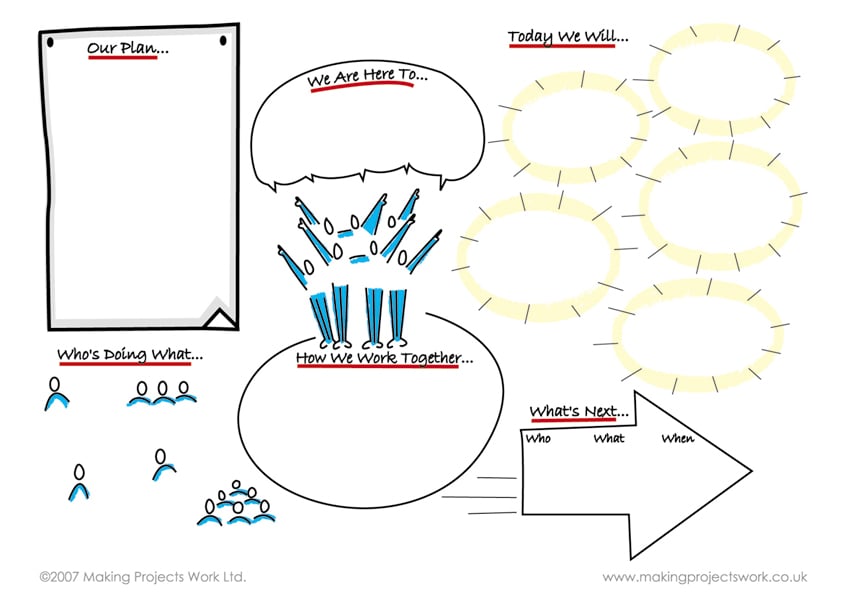Hybrid collaboration: 8 best practices for 2021
Written by Dr Penny Pullan Wednesday 01 September 2021
“Fully virtual meetings are great, but no good for creativity. We can only collaborate effectively when we’re in a room together.” This is a common sentiment, but does it hold water? Is creative collaboration really possible in hybrid and virtual settings?
As organisations return to their workplaces, people are looking forward to meeting in the same room as their colleagues to collaborate and innovate. They have found collaboration online difficult or even impossible – but this doesn’t need to be the case. I, along with many others, have been working effectively with remote colleagues for nearly two decades, and even wrote a book about it: Making Workshops Work: Creative Collaboration for Our Time. But deep, creative collaboration is highly unlikely to happen on its own. Indeed, most people have yet to experience a really effective virtual or hybrid workshop and, as a result, they assume it just isn’t possible. But it is. Just keep in mind these dos and don’ts as you prepare:
1. Do be aware of the challenges
If you do nothing, those together in the room will have a built-in advantage over those who are on their own and joining remotely. Those together in a room will be able to experience the full richness of in-person communication with each other, plus pick up the subtleties and nuances of conversation in a way that just isn’t possible virtually. They can also catch up over coffee or around the water cooler for a chat before or after the session, or during breaks. Too often, those in the main room forget about remote participants and remote rooms, as they enjoy discussions between those they can see in person.
2. Do create a level playing field
How can we counteract the in-built advantage for those in the room? There are many options, and here are just a few (find more ideas in the book):
- You can always run workshops with everybody joining remotely so that everyone is in the same boat.
- If most participants will be in the room, it’s helpful to have a physical reminder of remote people so that they can’t be forgotten. Life-size cartoon cutouts of people work really well, especially when each is propped up on a chair at the table.
- In-room buddies for each remote participant can keep them updated, answer their questions and advocate for them in the meeting.
- Think remote-first and always ask remote participants for their input before those in the room.
Keep those not in the room top of mind.
Want more hybrid working tips?
Explore CMI’s Better Managers Roadmap, a research-based guide designed to equip you as we move to a world of hybrid and flexible working. The first pillar, Hybrid Working, explores what hybrid working could look like and how to implement it in your organisation.
Explore the Better Managers Roadmap
3. Don’t think that success is all about technology
Virtual technology is an enabler only – it allows people to join remotely, but that is all. Consider it just as you would electricity in a house: it’s necessary to create a comfortable home, but once it’s working, you forget about it and focus on other things.
4. Do design your session for collaboration
To maximise collaboration and creativity, I suggest the following steps:
- What’s your purpose?
- Which people should be involved, given that purpose?
- What process will you use to take you from the beginning to the end, where you will have achieved your goals and met your purpose?
5. Do provide extra clarity
Provide even more clarity than you would with everyone in a room. My Magic 6TM is particularly helpful for this: it’s simply six statements to use during preparation and then gain agreement on at the start of your session. Together, they clarify the purpose, the objectives, the time plan, the roles, the ground rules that people agree to work by and the actions:

6. Don’t limit yourself with videoconferencing
There are many virtual collaboration tools that you can use to replace a physical whiteboard and sticky notes. Use these to stimulate discussion and interaction.
7. Do use visuals
It’s really helpful to be able to see holistic and engaging visuals that link things together and bring ideas to life. These are especially useful for remote participants as live drawing keeps people focused on the screen and curious as to what’s coming next. Why not encourage everyone to join in with creating visuals to make it even more engaging?
8. Don’t assume it isn’t possible
Don’t make the assumption that you need to have everybody in the room in-person before you can do anything collaborative together. There are many ideas and people who have been doing this effectively for decades who can help.
The key message is that creative collaboration is possible and these tips will help – plus, many will improve your in-room meetings as well!
Find more hybrid working tips in CMI’s Better Managers Roadmap.
Learn more in Penny’s book, Making Workshops Work (PIP, July 2021), which became a bestseller on launch day. As a CMI member, you can also enjoy 20% off Penny’s previous book, Virtual Leadership, on the Kogan Page website with discount code VLF20.
Image: Shutterstock/Andrey_Popov
You might also like these posts on this topic:
Filling in the Gaps Report
This research highlights the ongoing challenges in closing the gender pay gap.
“As managers, we can help improve the UK economy”
Simon Takel CMgr FCMI on how CMI resources help him navigate change in the further education sector
Pink suits and ice-breakers: what we learned at CMI Communities Live, Birmingham
Experts gathered in the West Midlands to share their ideas for future-proofing leadership
“I haven’t finished developing – I’ve got more to offer”
Gem Fletcher launched her own business podcast and consultancy. She breaks down her commitment to ongoing development…
Don’t miss out - get notified of new content
Sign-up to become a Friend of CMI to recieve our free newsletter for a regular round-up of our latest insight and guidance.
CMI members always see more. For the widest selection of content, including CPD tools and multimedia resources, check out how to get involved with CMI membership.
Advice
Looking for advice and guidance? Whether you are looking for topical tips or information, you can find the latest advice and guidance from the CMI team here.
Members See More
CMI Members have access to thousands of online learning and CPD resources. Learn more about our membership benefits
Join The Community
CMI offers a variety of flexible membership solutions, tailored to your needs. Find out more and get involved in the CMI community today.
